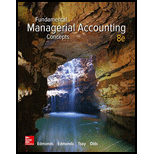
a.
The cost items that is relevant to make-or-outsource decision.
a.
Explanation of Solution
Special order decisions: Special order decisions include circumstances in which the board must choose whether to acknowledge abnormal customer orders. These requests or orders normally necessitate special dispensation or include a demand for lesser price.
Decision making: It is a vital capacity in the management, since decision making is identified with issue, a compelling decision making accomplishes the preferred objectives or goals by taking care of such issues.
The cost items that are relevant to make-or-outsource decision are as follows:
The unit-level costs of creation can be avoided if the Product X is bought. Likewise, it is sensible to accept that the cost the salary of production supervisor can be avoided if the manufacturing development is rejected. Since Company R will keep on promoting the item, the selling costs, product-level advertising cost, and facility-sustaining costs will proceed irrespective whether Product X is made or bought. These costs may not be avoided by obtaining the Product X. Thus, the below items would be relevant to the make-or-outsource decision. The items that relevant to make-or-outsource decision is mentioned in the below part.
Determine the total avoidable costs
Therefore the total avoidable cost is $350,000.
b.
Whether Company R continue to make the product or buy from the supplier by determining the change in net income.
b.
Explanation of Solution
Determine the cost per unit
Therefore the cost per unit is $3.50.
Determine the increase in net income
Therefore the increase in net income is $30,000.
The reason on whether Company R would continue to make the product or buy from the supplier is as follows:
The avoidable cost per unit of manufacturing the Product X is $3.50 per unit. Since the cost to buy is $3.20, Company R can lessen costs by buying instead of producing the item. Consequently, outsourcing the item would expand income by $30,000.
Therefore Company R should purchase the product.
c.
Whether Company R should buy Product X if sales increase by 60,000 units.
c.
Explanation of Solution
Determine the avoidable costs
Therefore the avoidable cost is $464,000.
Determine the cost per unit
Therefore the cost per unit is $2.90.
The reasons on whether Company R should buy Product X if sales increase by 60,000 units is as follows:
The cost of the supervisor’s salary is fixed with respect to the number of units of Product X manufactured and sold. Likewise, the cost per unit will drop as a result of increase in sales. At the current level of 160,000 units the avoidable cost per unit is lower to manufacture at $2.90, than to purchase at $3.20. Company R should keep on making the Product X. As this issue illustrates, the decision to outsource should think about the opportunity of future development and also present production.
Therefore Company R should continue to make the product.
d.
The qualitative factors that Company R should consider before deciding to outsource Product X.
d.
Explanation of Solution
The qualitative factors that Company R should consider before deciding to outsource Product X is as follows:
Before focusing on the outsourcing decision, Company R must think about the capacity of the provider to furnish Product X as per the organization's quality norms. Likewise, Company R must guarantee itself that the item will be conveyed on an appropriate premise. By outsourcing, Company R is losing the advantages of vertical integration. The organization is subject to the provider's execution.
The loss of control should be weighed in contradiction of the advantages of cost reduction. Company R can shield itself from inconsistent providers by keeping up a rundown of licensed providers. Company R should furnish these providers with hikes or incentives for providing exceptional services, for example, amount buys and quick invoice payment so as to increase favored customer standing. The provider in the scenario mentions the suppliers.
Want to see more full solutions like this?
Chapter 6 Solutions
Fundamental Managerial Accounting Concepts
- The following direct labor information applies to Summit Tech Co. for the month of April: • Actual labor rate = $12.50 per hour • Actual hours worked = 12,000 hours • • Standard labor rate = $12.00 per hour Standard hours allowed = 11,200 hours Calculate the following: 1. Labor rate variance 2. Labor efficiency variance 3. Total labor variancearrow_forwardI am searching for the correct answer to this general accounting problem with proper accounting rules.arrow_forwardI am looking for the correct answer to this financial accounting problem using valid accounting standardsarrow_forward
- Can you help me solve this financial accounting question using valid financial accounting techniques?arrow_forwardIn November, one of the processing departments at Miyake Fabrication had beginning work in process inventory of $42,000 and ending work in process inventory of $35,000. During the month, $248,000 of costs were added to production. In the department's cost reconciliation report for November, the cost of units transferred out of the department would be $ ?arrow_forwardCan you solve this financial accounting problem using appropriate financial principles?arrow_forward

 AccountingAccountingISBN:9781337272094Author:WARREN, Carl S., Reeve, James M., Duchac, Jonathan E.Publisher:Cengage Learning,
AccountingAccountingISBN:9781337272094Author:WARREN, Carl S., Reeve, James M., Duchac, Jonathan E.Publisher:Cengage Learning, Accounting Information SystemsAccountingISBN:9781337619202Author:Hall, James A.Publisher:Cengage Learning,
Accounting Information SystemsAccountingISBN:9781337619202Author:Hall, James A.Publisher:Cengage Learning, Horngren's Cost Accounting: A Managerial Emphasis...AccountingISBN:9780134475585Author:Srikant M. Datar, Madhav V. RajanPublisher:PEARSON
Horngren's Cost Accounting: A Managerial Emphasis...AccountingISBN:9780134475585Author:Srikant M. Datar, Madhav V. RajanPublisher:PEARSON Intermediate AccountingAccountingISBN:9781259722660Author:J. David Spiceland, Mark W. Nelson, Wayne M ThomasPublisher:McGraw-Hill Education
Intermediate AccountingAccountingISBN:9781259722660Author:J. David Spiceland, Mark W. Nelson, Wayne M ThomasPublisher:McGraw-Hill Education Financial and Managerial AccountingAccountingISBN:9781259726705Author:John J Wild, Ken W. Shaw, Barbara Chiappetta Fundamental Accounting PrinciplesPublisher:McGraw-Hill Education
Financial and Managerial AccountingAccountingISBN:9781259726705Author:John J Wild, Ken W. Shaw, Barbara Chiappetta Fundamental Accounting PrinciplesPublisher:McGraw-Hill Education





